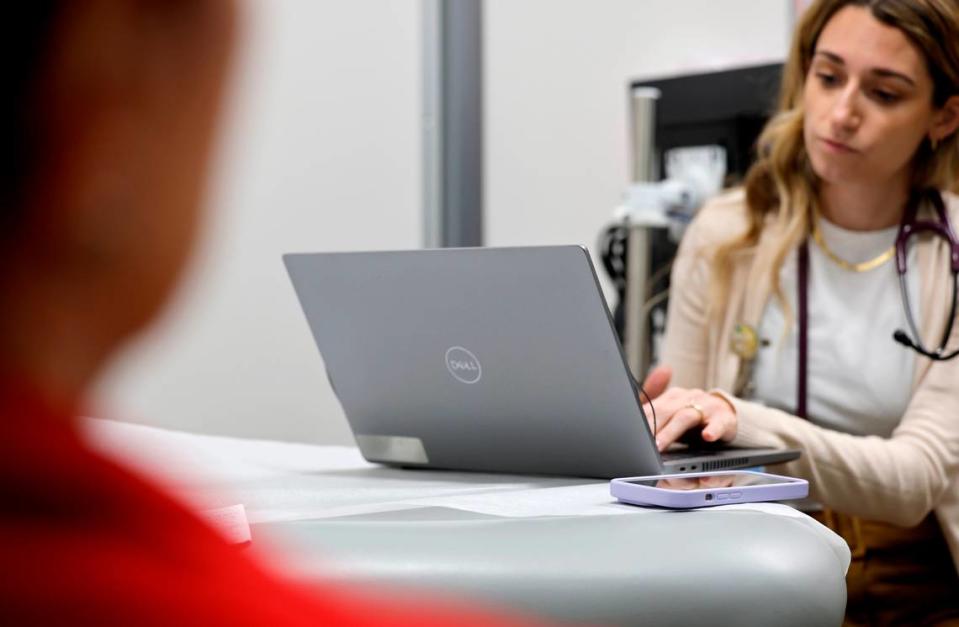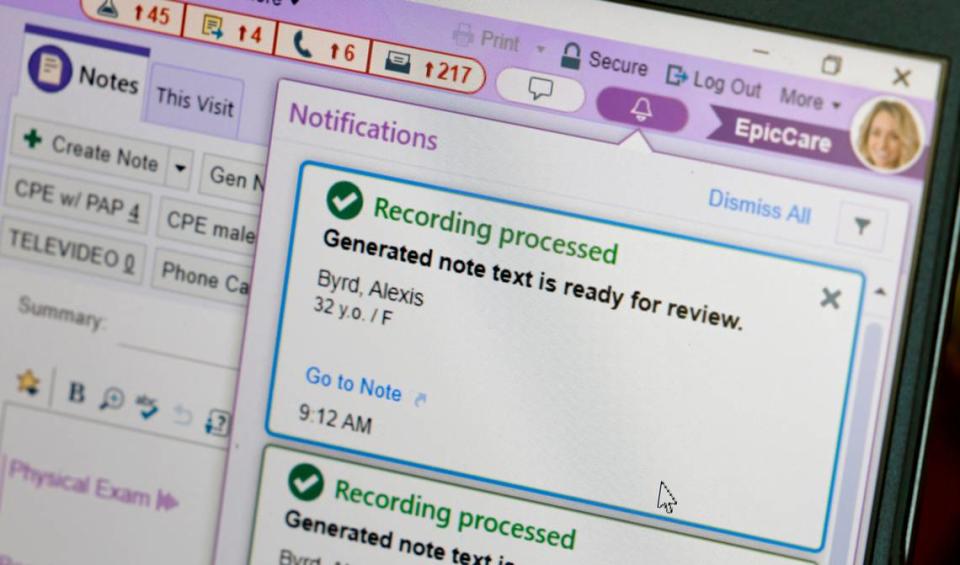Doctor’s notes that write themselves? UNC Health tests AI so focus can be on patients
In the health care industry, there is a common adage: If you didn’t document it, it didn’t happen.
For a combination of legal, medical and billing reasons, doctors spend hours every day in front of their computers, meticulously writing down what they said to patients and what patients said back.
But exhaustive documentation comes at a cost.
For every hour spent seeing patients, doctors spend two hours on desk work, according to an analysis of physicians in various specialties, a fact that they say muddies their work-life balance and fuels feelings of burnout.
Patients harbor similar feelings of resentment toward their doctor’s computer, which they feel pulls attention away from them during appointments.
That complaint is well described by a 7-year-old’s crayon depiction of her pediatrician appointment (which was later printed in the Journal of the American Medical Association). In one technicolor corner, the little girl smiles beside her family and in the other, the doctor is turned away from her, hunched over his computer.
With a new artificial intelligence tool called DAX Copilot, UNC Health hopes to change that picture.
The tool — developed by Microsoft and software company Nuance Communications — takes a recording of patient appointments, feeds the clip through a secure version of Chat GPT-4, and produces paragraphs of documentation for the doctor to approve or alter.
In effect, DAX Copilot makes a clinical note “write itself.”
Thirty-four UNC Health doctors from select specialties, like family medicine and general pediatrics, began testing the tool in mid-September.
At the end of the pilot in January, leaders at UNC Health, one of the first adopters of this technology, will evaluate whether the software makes good on its promise to reduce physician burnout and “bring joy back to the practice of medicine.”

A welcome relief
A few minutes after her third annual checkup of the day, Sarah Garwood, a physician assistant at UNC’s Panther Creek office, sat at her desk and opened a blank page in her patient’s chart.
She and her patient had covered a lot of ground during the 20-minute visit— they talked about holiday plans, back problems, hand pains, exercise regimens — and Garwood hadn’t jotted down a word of it.
Instead, she placed her lilac-cased cellphone between them and let DAX Copilot record the conversation.
With a click of a button, the blank screen suddenly populated with paragraphs of text.
Complaints about her patient’s back, which had been mentioned at various points during the appointment, were consolidated into one paragraph. Unnecessary details — like what she ate for breakfast that morning — were omitted.
She fixed some small typos and her patient’s medical history was finished.
For Garwood, who said she spends almost “every minute of every day” typing up notes, sitting in the editor’s seat instead of the writer’s has been a welcome relief. She wraps up patient notes faster and feels less mentally fatigued afterward, she said.
She also felt her interactions with patients shift.
During appointments, she walks past the exam room’s corner computer and pulls up a chair a few feet in front of her patient. Unburdened by typing, she has time to make eye contact or look through the patient’s chart for relevant lab work.
“I’m just spending more time interacting with the patient,” she said. “I feel like my mind isn’t as jumbled.”

Dr. Carl Seashore, a UNC Health pediatrician who also began piloting the tool in September, said some of his patients’ parents had commented on the change.
“It’s something I hear from my patients all the time: ‘Wow, you like actually sit here and like play with the kid and interact with us and make eye contact?’” he said. “Before this, I would just sort of create a little triangle with the patient, the computer and me.”
Dr. Deborah Rasmus, a family medicine doctor whose cubicle neighbors Garwood’s, said after she started using DAX Copilot her notes weren’t just faster, they were better.
Rasmus pulled up a note that the algorithm helped write — it was filled with meaty paragraphs that she said created a “nice narrative” of everything she discussed with her patient.
She compared it to a note she had written herself. Hers was a far shorter and sparser collection of sentences, which she described as a “broken-up puzzle” of the patient’s problems.
“I feel like my note quality is not as good as what the DAX could write,” she said.
A delicate balance
Writing a clinical summary is more complicated than merely transcribing a patient-doctor conversation.
Good note-taking involves a series of judgment calls to determine whether each detail is clinically relevant.
Too few details, and the summary lacks enough context to base medical decisions on. Too many details and the note becomes bogged down in “sludge,” making it long-winded and unhelpful.
DAX Copilot has not perfected this delicate balancing act.
Sometimes the doctors at the Panther Creek clinic like to trade stories and giggle at the absurd sentences the algorithm deemed important enough to enshrine in legal medical records, like “He eats rice.”
In the section of notes dedicated to the discussion of diagnoses, doctors said the algorithm routinely skimps on details.
Occasionally, DAX makes a more fundamental miscalculation about the appointment.
Garwood recalled an instance in which DAX incorrectly assumed her adult patient with Down syndrome, who was accompanied by her sister, was a child with her mother.
The hope is that the algorithm will learn from all of the doctors’ edits over time and produce drafts that are closer and closer to what they would have written themselves.
At the end of the pilot, some doctors who use medical scribes — now referred to as “human scribes” or “live scribes” by many of the pilot’s participants — may face a difficult decision.
“I don’t know what I’m going to do in January — am I going to continue with our live scribes?” said Seashore, who currently uses a mixture of DAX and medical scribes for note-taking.
While he finds their work helpful, working as a scribe is often a stepping-stone to medical school, which means there is a high turnover rate and a constant burden of training new hires.
And as an added bonus, computers don’t get sick, he pointed out.
Carson Triboletti, a scribe whose first day at Panther Creek coincided with the start of the DAX pilot, said the technology has forced him to examine some big questions about his job, like, Do human scribes offer something that computers cannot?
He said he hasn’t come up with a good answer yet.
Teddy Rosenbluth covers science and health care for The News & Observer in a position funded by Duke Health and the Burroughs Wellcome Fund. The N&O maintains full editorial control of the work.
Some UNC Health doctors will use AI to message patients in the My Chart patient portal
Duke Health and Microsoft partner on ‘game-changing’ AI health care tools

